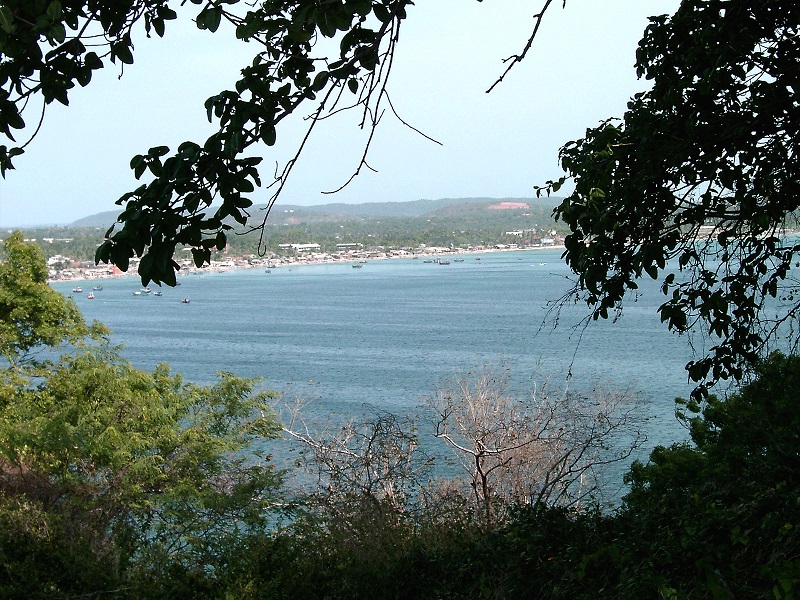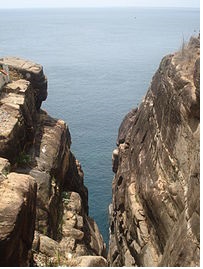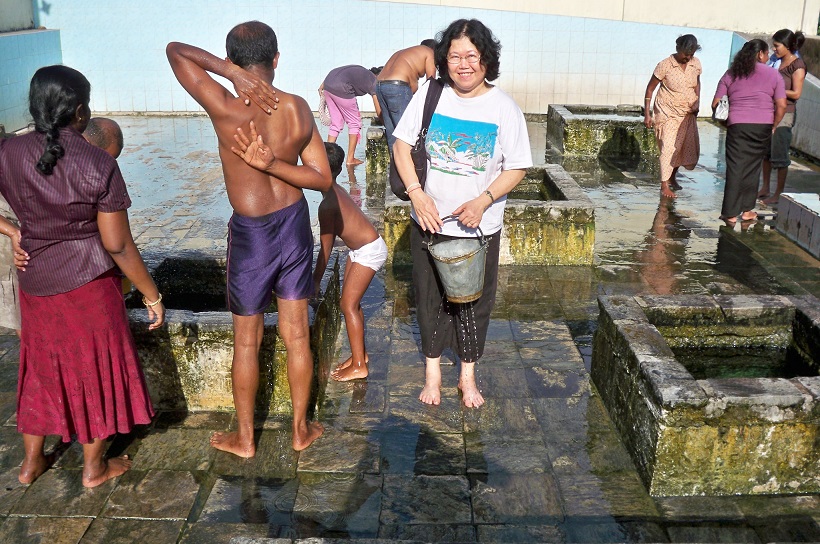Travels of a journalist [2013 Series #8] Trinco offers Hot Wells, forts, beaches, Koneswaram Kovil & smashing dosa
Posted on July 8th, 2013
By Shelton Gunaratne, author of Village Life in the Forties: Memories of a Lankan Expatriate (Bloomington, IN: iUniverse); and From Village Boy to Global Citizen Vol. 1& Vol.2 (Bloomington, IN: Xlibris).
This yearƒÆ’‚¢ƒ¢-¡‚¬ƒ¢-¾‚¢s was my first trip to Trincomalee (pop. 99,135), the administrative center of the Eastern Province occupying an area of 750 hectares spreading outward from the peninsula that intrudes between the Back Bay and the inner harbor. It doubles as a scenic seaside resort area that also serves as an economic and military hub for Sri Lanka. Its two deep-water natural harborsƒÆ’‚¢ƒ¢-¡‚¬ƒ¢¢”š¬‚inner and outerƒÆ’‚¢ƒ¢-¡‚¬ƒ¢¢”š¬‚provide the port facilities for the countryƒÆ’‚¢ƒ¢-¡‚¬ƒ¢-¾‚¢s exports and imports, and the naval facilities for the countryƒÆ’‚¢ƒ¢-¡‚¬ƒ¢-¾‚¢s security. No wonder that the European invaders wanted to control it since the 16th century because of its strategic location.
We arrived in Trincomalee city on a hot Saturday (April 6) afternoon from Polonnaruwa ƒÆ’‚¢ƒ¢-¡‚¬ƒ¢¢”š¬‚a distance of 113 kmƒÆ’‚¢ƒ¢-¡‚¬ƒ¢¢”š¬‚along the northeast running Kandy-Trinco Road, which we reached by first heading northwest to Hatares Kotuwa on the Gal Oya-Minneriya Road.
Trincomalee.jpg mapA= Kanniya Hot Wells; B=Koneswaram Kovil; C= Fort Frederick; and D= Fort Ostenburg (Hoods Tower Museum).
Amal, our driver, decided to show us two attractions before dinner and nightfall. He did not want to waste the time and the gasoline to take us back and forth to the beach hotel we had reserved for the night more than 18 kilometers to the north.
Historic Koneswaram
So, our introduction to Trinco began with a stopover in front of Fort Frederick from where we had to walk up to the magnificent Koneswaram Kovil, which the Europeans called the Temple of the Thousand Pillars, the exact origin of which is yet unknown although the extant evidence has established its workmanship to contain features of classical antiquity. The shrine is on Swami Rock (Konamalai), 107 meters above the sea level. From this elevation, the multi-layered shrine complex offers awesome views of the Indian Ocean below through what is aptly called the LoversƒÆ’‚¢ƒ¢-¡‚¬ƒ¢-¾‚¢ Leap or RavanaƒÆ’‚¢ƒ¢-¡‚¬ƒ¢-¾‚¢s Cleft.
The temple requires the visitors to enter the shrine barefooted irrespective of the season. Thus, April is not the best time to explore Hindu and Buddhist historical sites in the lowlands of Sri Lanka because this custom has increased suffering (dukkha) among folks who burn their feet by walking barefooted on scorched earth.
 The scenic Trincomalee(Courtesy: Wikipedia)
The scenic Trincomalee(Courtesy: Wikipedia)
We entered the shrine through its partially restored decorated gateway. We learned that the Portuguese attacked and destroyed the temple on April 14, 1662ƒÆ’‚¢ƒ¢-¡‚¬ƒ¢¢”š¬‚the Hindu New YearƒÆ’‚¢ƒ¢-¡‚¬ƒ¢-¾‚¢s Day. The Dutch prohibited the performance of any religious ceremonies on Swami Rock. The restoration work on the temple began only in the 1950s. The Hindu Tamil interpretation of the history of Koneswaram is not consistent with that of the Buddhist Sinhalese.
Whatever the history of Koneswaram might be, we enjoyed the sea and landscapes of Trincomalee that it enabled us to see from each layer of the temple.
The Lovers Leap, also called RavanaƒÆ’‚¢ƒ¢-¡‚¬ƒ¢-¾‚¢s Cleft, at the Koneswaram Kovil, Trincomalee.(Courtesy: Wikipedia.com)
Two Forts and Two Ports
After absorbing the scenery from the temple, we went back to our vehicle parked in front Fort Frederick at the foot of Swami Rock/ Pagoda Hill to mull over the fortƒÆ’‚¢ƒ¢-¡‚¬ƒ¢-¾‚¢s history.
The original fort that the Portuguese built in 1625 on this spot overlooking TrincomaleeƒÆ’‚¢ƒ¢-¡‚¬ƒ¢-¾‚¢s outer harbor was dismantled by the forces of King Rajasinghe II (1635-1687) in 1643 after the Dutch captured the fort in 1639 and handed it over to the Kandyans with whom the Dutch had formed an alliance.
Subsequently, the Dutch built two forts in the 1660s. The first wasƒÆ’-¡ƒ”š‚ Fort FrederickƒÆ’-¡ƒ”š‚ at the foot of the promontory, which they called Pagoda Hill (where we had parked). The second was Fort Ostenburg, which they built on a ridge at the mouth of the inner harbor as a facility for the Dutch officers. The British gained control of the Dutch forts in January1782, but the French captured them in August of the same year.ƒÆ’-¡ƒ”š‚ Next, the British took control again in 1795 and held them until Ceylon gained independence.
Today, Fort Frederick remains garrisoned by a detachment of the Gajaba Regiment of the Sri Lankan army, but the facility is accessible to the public.
However, Fort Ostenburg, which was once described as “the most powerfully gunned fort in Ceylon” with strong batteries at sea level and many guns on the ridge above them, has retained very little of its glory primarily because of the British policy of constricting coastal artillery since 1920 (Wikipedia).
Now turned into the Hoods Tower Museum by the Sri Lanka Navy, Fort Ostenburg contains a collection of weapons, equipment and weapon systems used by the navy.ƒÆ’-¡ƒ”š‚ ƒÆ’‚¢ƒ¢-¡‚¬ƒ…-Prizes of WarƒÆ’‚¢ƒ¢-¡‚¬ƒ”š‚ƒÆ’-¡ƒ”š‚ on display include capturedƒÆ’-¡ƒ”š‚ Sea TigerƒÆ’-¡ƒ”š‚ attack crafts, suicide crafts andƒÆ’-¡ƒ”š‚ LTTEƒÆ’-¡ƒ”š‚ weapons, including an all terrain vehicle that Charles Anthony, the older son of Prabhakaran, used.
Because of time constraints, we could not drive the 19 km distance between Fort Frederick and Fort Ostenburg along the road that forms a semicircle around China Bay
Kanniya Hot Wells
From Fort Frederick, we immediately headed to get a feel of the seven Hot Wells of KanniyaƒÆ’‚¢ƒ¢-¡‚¬ƒ¢¢”š¬‚some 10 km northwest of the fort on the arterial road to Anuradhapura. The neighboring Mari Amman Kovil, which holds the lease for the property, controls and maintains the wells. Locals pay Rs. 10 (US 8 cents) and foreigners Rs. 50 (US 40 cents) to enter the wells and try out the reputed healing powers of the hot water springs.
A high wall bounds the rectangular enclosure, which houses all seven springs. In turn, a dwarf wall encloses each spring to form a well. The temperature of each spring varies slightly. Wells are only about a meter deep, so one can clearly see the bottom. Bathers cannot use soap within the enclosure, but a facility for that is available a few meters away. When the number of users exceeds the number of wells, the users have to quickly move from well to well to get a sample of each. We were satisfied with one bucket of water from each well to wash our feet.
At the Kanniya Hot Wells: Yoke-Sim mixes with the local bathers.
Hundreds of hot springs exist in the world. As I left the premises, the thought occurred to me that the Kanniya Hot Wells could be turned into a money spinning modern spa that would attract wealthy tourists from East Asia.
Gobbling Smashing Dosa
I was pining for a saapadu (meal) of dosa (fermented crepe/pancake made from rice batter and black lentils) and masala vadai (savory fritters made of potatoes, lentils and onions) that I had not eaten for more than a decade. I yearned for the genuine food that only an authentic Tamil cook could make. I remembered my years at Lake House in the early ƒÆ’‚¢ƒ¢-¡‚¬ƒ”¹…”60s when I ate dosa for lunch at Tamil boutiques on Hospital Road in Colombo Fort. I thought that Trincomalee would be the ideal place to taste such a delightful meal.
Amal understood my craving pretty well, so he drove us back to the cityƒÆ’‚¢ƒ¢-¡‚¬ƒ¢-¾‚¢s crowded Main Street in the peninsula. Amal made inquiries from a few locals to decide on the restaurant to go for our saapadu. When we sat down at our table, the manager welcomed us in English and told us the options he could offer. He preferred to serve us the delectable food on platters rather than on banana leaves.
Our party of three thoroughly enjoyed the smashing saapadu.ƒÆ’-¡ƒ”š‚ It seemed incredible that the total charged for the food and service came to a mere Rs. 550 (less than $5). Obviously, the good restaurateur did not want to fleece the ƒÆ’‚¢ƒ¢-¡‚¬ƒ…-foreigners.ƒÆ’‚¢ƒ¢-¡‚¬ƒ”š‚
A Night by Nilaveli Beach
From the city, we had to drive 19 km along the north coast road to check-in for the night at Hotel Coral Bay on FishermanƒÆ’‚¢ƒ¢-¡‚¬ƒ¢-¾‚¢s Lane, Nilaveli Beach. We paid Rs.6,600 (about $ 52) for bed and breakfast. Because we were tired, we went straight to bed.
We didnƒÆ’‚¢ƒ¢-¡‚¬ƒ¢-¾‚¢t notice the beauty of the beach until the morning when we were invited for breakfast in a hut on the beach just a few meters away from our room and the backyard swimming pool. It was still too early for any tourist to come out for a dip in the pool or in the ocean.
Regrettably, we had to leave the Nilaveli Beach quite early to head for Mannar on the west coast. We were not inclined to visit the other scenic and sandy beaches in TrincoƒÆ’‚¢ƒ¢-¡‚¬ƒ¢¢”š¬‚Uppuveli, Marble, Pigeon Island, etc.ƒÆ’‚¢ƒ¢-¡‚¬ƒ¢¢”š¬‚either.


